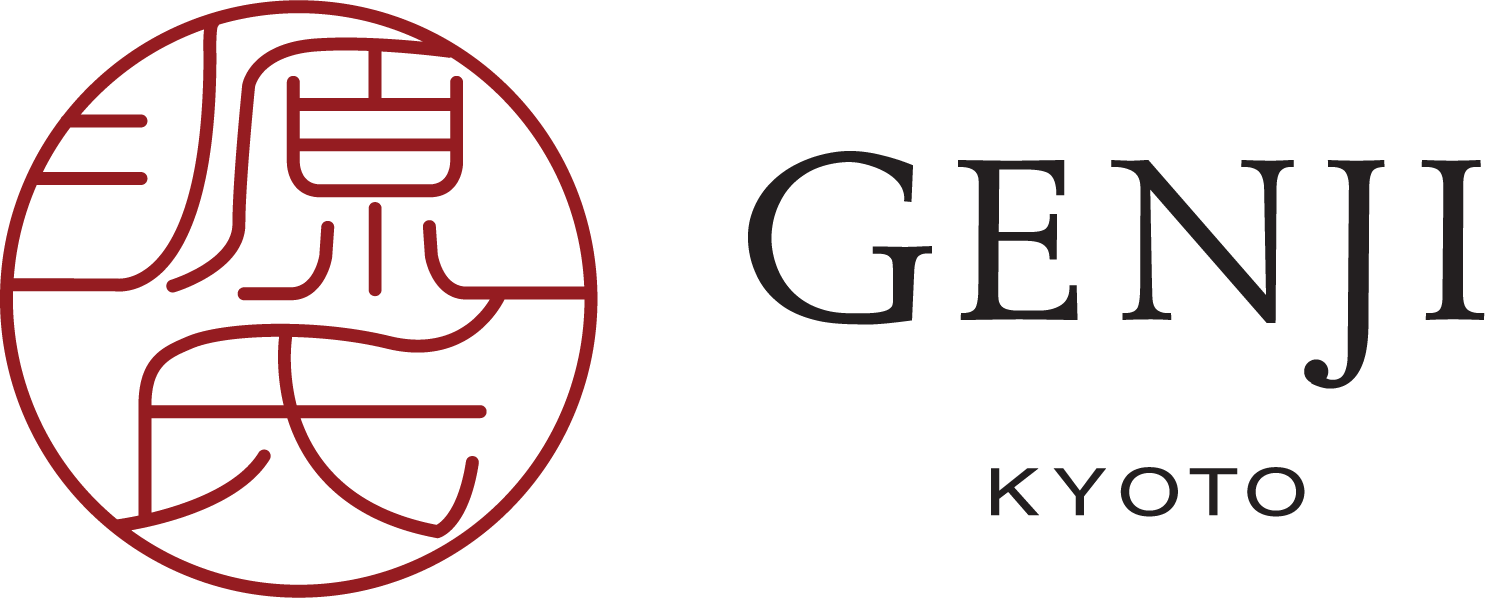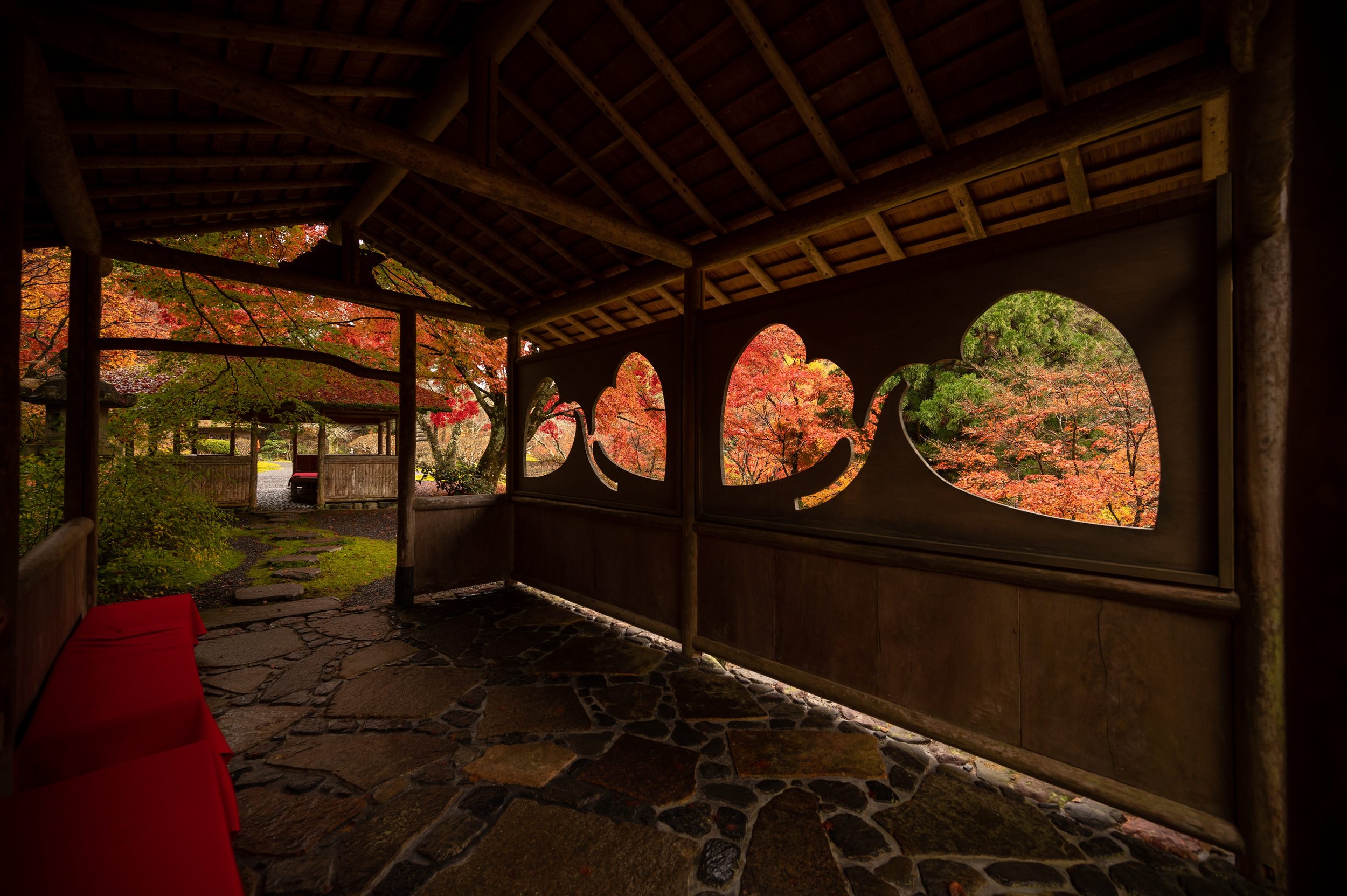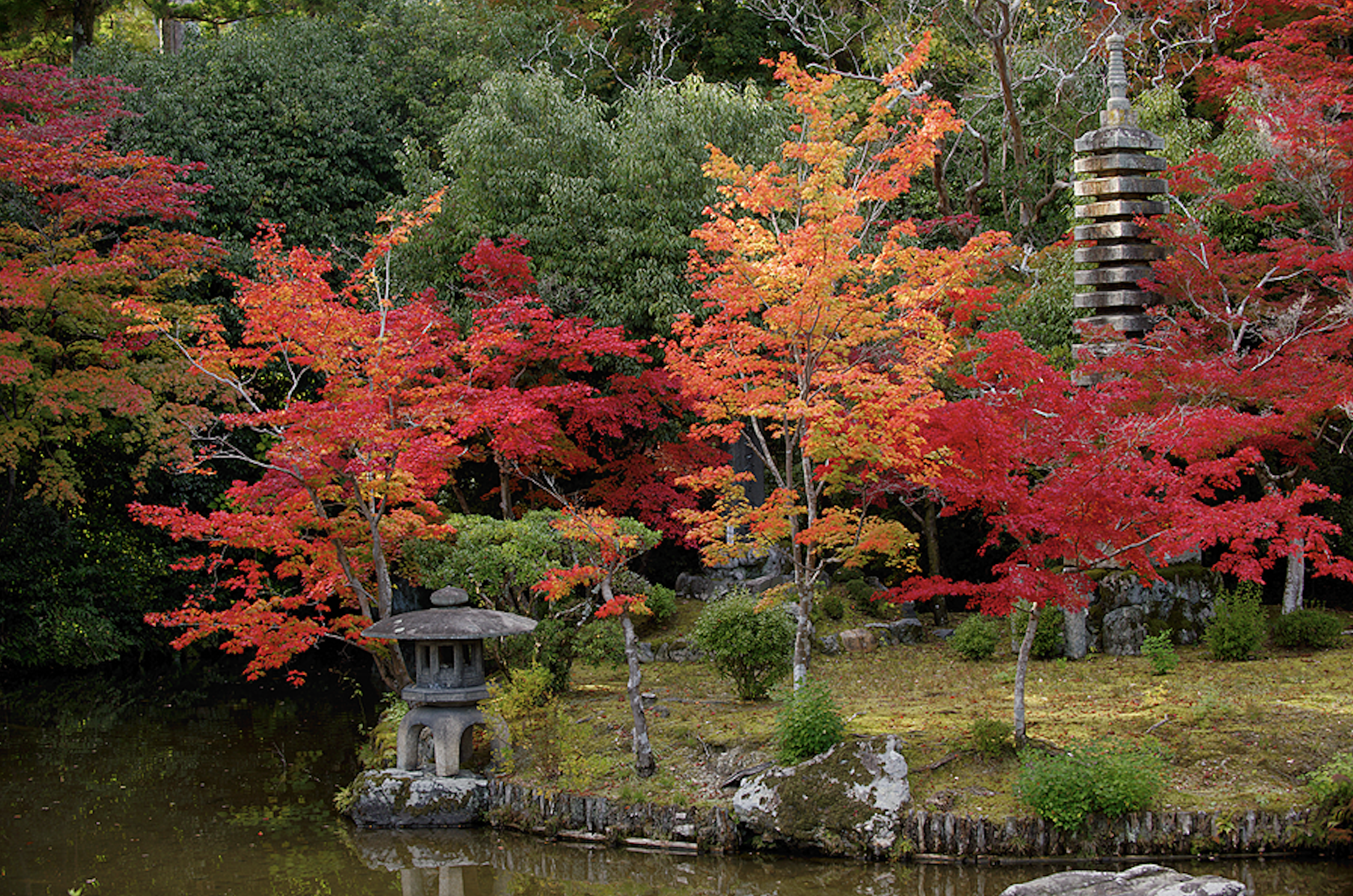Off the Beaten Track Kyoto Autumn Colors
Hakuryū-en (白龍園), a private garden along the Eizan Railway Line. Photo by Konosuke @kyotophotograph.
Kyoto's top spots for viewing autumn foliage make bucket lists for good reasons: the sheer number of maples within a venue; vibrant colors in the day and added lustre with illumination by night; a growing volume of shared images ensuring ever greater popularity.
But sometimes treading a less beaten path can be a more rewarding experience, and Kyoto has many wonderful spots that reveal an unimaginable harmony of nature and culture.
Our map here highlights the most popular as well as the less visited spots for autumn foliage. We hope it can help you find the spots that best suit your itinerary, and add to your treasure trove of things to do in Kyoto.
Here is our by-area list of the lesser known but no less attractive spots for an autumn experience:
Higashiyama 東山
Sennyū-ji 泉涌寺 and subtemple Unryū-in 雲龍院
Sennyū-ji, meaning Temple of the Flowing Spring, and Unryū-in, Temple of the Cloud Dragon are both in the vicinity of the hugely popular Tōfuku-ji temple but with far fewer visitors. Both have beautiful gardens and halls. There are usually evening illuminations at Unryū-in. We recommend going by taxi, as there will be a 15-25 minute walk from any of the nearest bus, train or subway stations. A taxi ride from Kyoto Station will take about 10 minutes.
Shinnyodō 真如堂
This is a temple much loved by locals for sceneries that are beautiful in all seasons, and particularly photogenic in autumn.
Konkai Kōmyō-ji 金戒光明寺
This temple is a stone's throw from Shinnyodō and has an impressive garden that is only open in peak seasons, often with evening illuminations.
Central Kyoto 市内中心エリア
Rozan-ji (廬山寺) has a Genji Garden. Photo by Damien Douxchamps
Rozan-ji 廬山寺
This small temple next to the Kyoto Imperial Palace is famous for its connection with Murasaki Shikibu, the author of the Tale of Genji, which inspired a Genji Garden. Most people come for the purple bellflowers in July. But the autumn foliage juxtaposed with pine trees and islands of moss is enchanting in this unique garden.
Shōkoku-ji 相國寺
This is the main temple of the Buddhist Rinzai sect under which are the Golden Pavilion and Silver Pavilion temples (Kinkaki-ji and Ginkaku-ji). Its vast grounds with classic temple structures and a garden that combines elements of landscape and dry gardens make for magnificent backdrops to autumn colors. The best thing is it usually has very few visitors.
Shōkoku-ji (相國寺) Photo by Damien Douxchamps
Myōkaku-ji Hōshī-en 妙覺寺 法姿園
This temple has an interesting history, with warlord Oda Nobanaga staying in it for 18 of his 20 trips to Kyoto. Its Hōshī-en garden is an unusual "natural" garden where there is no particular landscaping or Zen elements, with maples simply being there with the moss, to be appreciated just as they are.
Myōkaku-ji Hōshī-en (妙覺寺 法姿園) during light-up. Photo by Damien Douxchamps
Myōken-ji 妙顯寺
This temple was favored by Toyotomi Hideyoshi as his lodgings in Kyoto during the war years. Both its spring and autumn sceneries are spectacular, especially during light-ups. It is an underrated spot for autumn colors.
Eizan Railway Area 叡山電鉄界隈
Eizan Railway starts from Demachiyanagi Station. For temples such as Shisendō, Enkō-ji, Manshu-in, and Rengei-ji, choose the train bound for Yase-Hieizanguchi. For Myōman-ji, Kifune Jinja, Kurama-dera and the unique Hakuryū-en garden, choose the train bound for Kurama.
Shisendō 詩仙堂
This villa, best known for its azaleas and 36 portraits of Chinese poets, is very famous and tends to be crowded at peak seasons. It is about 15 minutes walk from the Ichijōji Station.
Enkō-ji 圓光寺 - advance booking required
Enkō-ji is next to Shisendō and also very popular. But because it requires advance booking for autumn viewing, there won’t be uncontrollable crowds.
Manshu-in 曼殊院
Manshu-in (曼殊院) is 15 minutes walk from Shūgakuin Imperial Villa and can be visited together. Photo by Konosuke @kyotophotograph.
Manushu-in is known for its autumn scenes both inside and outside the temple. But because it is a little farther off - a 25-minute walk from the nearest Shūgakuin Station - it is usually not too crowded.
Rengei-ji 蓮華寺
Rengei-ji (蓮華寺) with an atmospheric pond garden seen from the main hall. Photo by Konosuke @kyotophotograph
This small temple with a beautiful pond garden is well-known for its autumn views. Due to its small size it can get a little crowded. An early morning visit is recommended. From the Miyakehachiman Station, it is about a 5-minute walk.
Myōman-ji 妙満寺
This large temple with a Snow Garden is best known for its winter scenery. But it is also picturesque in spring and autumn, with plenty of cherry and maple trees planted around the vast grounds. It is a little out of the way, but is in fact very easy to get to. From the Kino Station of the Kurama-bound Eizan train, it is just a 5-minute walk.
Kurama-dera 鞍馬寺
This mountain temple with spectacular autumn colors is at the end of the Kurama-bound Eizan Railway. You get to experience going through a “Maple Tunnel” in peak season!
Hakuryū-en 白龍園 - advance reservation required
This private villa is only open on fixed dates in cherry blossoms and autumn foliage seasons. It is a short walk from Ninose Station of the Kurama-bound Eizan Railway. For viewing autumn colors, tickets have to be applied for in advance. Only 50 people are allowed in at any hour between 10:00 and 14:00 by appointment, for a time limit of 2 hours (1 hour if you have the 13:00 appointment).
Momiji viewing through interesting windows at Hakuryū-en Garden. Photo by Konosuke @kyotophograph
Ōhara 大原
Ōhara is a village area in northeast Kyoto with great scenic beauty. It is way beyond the end of the Eizan Railway line. But taking the Eizan train part of the way is still more direct than taking a bus from city center. We recommend taking the Yase Hieizanguchi-bound train from Demachiyanagi Station to the last stop, followed by a taxi ride. One can also take Bus #17 from Miyake-Hachiman Station, but it does not run frequently. On the way back from Ohara, there will be a long queue at the bus stop, so we recommend taking a taxi back to a stop on the Eizan Railway.
Sanzen-in 三千院
This main temple in the Ōhara area borders a quaint village with a stream running through it. It is very popular with locals and will be more crowded than the nearby smaller temples. If you take the Eizan Railway to Miyakehachiman station, and from there take the #17 bus to Ōhara, you can walk to Sanzen-in in about 12 minutes. Sanzen-in can be the starting point for the next 3 temples, all of which have wonderful autumn colors.
Jikkō-in 実光院
Hōsen-in 宝泉院
Jakkō-in 寂光院
Arashiyama Area 嵐山エリア
Daikaku-ji 大覚寺
Apart from Tenryū-ji, which is a top destination for all seasons, Daikaku-ji is the next popular large temple in Arashiyama. It is less crowded because it is a little further away from both the Saga-Arashiyama JR Station and the Arashiyama Station of the Randen Tram.
Rokuō-in 鹿王院
Photo by Damien Douxchamps
This temple is a hidden gem in Arashiyama. It has fantastic autumn views, with a maple-covered walkway from gate to temple hall. And it is less than 10 minutes walk from Saga Arashiyama station (even closer if you take Randen tram and get off at Saga station). But it is not well-known and less visited.
Seiryō-ji 清涼寺
This third largest temple of the Arashiyama area is about midway between Saga-Arashiyama Station and Daikaku-ji, but is often bypassed. From its main hall overlooking a pond garden, it has one of Kyoto’s best autumn vistas.
The pond garden of Seiryō-ji in Saga-Arashiyama. Photo by Damien Douxchamps
Okochi Sansō Villa 大河内山荘庭園
This villa with gardens at the end of the Bamboo Grove is one of the most beautiful spots. But because it has a high admission fee (1,000 yen), many visitors choose to bypass it. You can enjoy the splendor of nature + culture here with usually smaller crowds.
North of City Center 京都中心地より北のエリア
Daitoku-ji Kōrin-in 大徳寺 興臨院
This small sub-temple is famous for its azaleas in spring and foliage in autumn, and is open only during these special viewings. There are not many maples on the premises, but they grace spots that make for photogenic compositions.
Genkō-an 源光庵
This small temples is famous for its round and square windows, symbolizing enlightenment and delusion. It can be visited together with the nearby Kōetsu-ji temple, which has a maple-covered walkway and a stroll garden.
Kōetsu-ji 光悦寺
Not far from Genkō-an is Kōetsu-ji, a temple converted from a villa, with 7 tea houses and open views of surrounding mountains.
Shōden-ji 正伝寺
This small temple has a garden that brings to mind the Hōjō gardens of Nanzen-ji and Ryōan-ji, with a back wall enclosing a dry Zen garden, with cherry and maple trees adding colors and allure in the right season. Instead of rocks, this temple’s garden has mounds of azalea shrubs representing lion cubs crossing the river.
Garden of Shōden-ji (正伝寺) with manicured shrubs representing lion cubs crossing the river. Photo by Konosuke @kyotophograph.
Takao Mountains 高雄山
The next 3 temples are near one another and they are the main temples of this mountain area. Jingo-ji is the most remote one. They are all quite hard to get to from central Kyoto. Even though this area is accessible by buses, many transfers will be needed. However, if you go by car or taxi from Ryōan-ji, which is a very popular destination, it takes only 20 minutes because the route is most direct. Unlike Ryōan-ji, these temples will not be crowded. But if you want to experience deep tranquility, go to Jōshōkō-ji, the temple truly far from the madding crowds.
Jingo-ji (神護寺) by Damien Douxchamps
Saimyō-ji (西明寺)
Kōzan-ji (高山寺), a World Cultural Heritage site. Photo by Damien Douxchamps
Jingo-ji 神護寺
Kōzan-ji 高山寺
Saimyō-ji 西明寺
Jōshōkō-ji 常照皇寺
This remote temple has a very old and special cherry tree sought after by photographers. It also has stunning autumn colors. It is best combined with visits to the Takao Mountain temples if you have a car. There is an admission charge to the temple but parking is available and free. From Kōzan-ji, it would be about 30 minutes by car. And you may be the only one there!
The remote but breathtakingly beautiful Jōshōkō-ji (常照皇寺). Photo by Konosuke @kyotophograph
West of City Center 京都中心地から西エリア
Myōshin-ji Daihō-in 妙心寺 大法院
Daihō-in is a sub-temple of Myōshin-ji, and is only open in high seasons. The moss garden with a tea house is most beautiful when the maples turn fiery.
Serenity at Daihō-in (大法院). Photo by Konosuke @kyotophotograph
Jōjū-ji 浄住寺
This is a quiet temple with a picturesque maple-covered walkway. It is about a 10-minute car ride from Katsura Imperial Villa.
Yamashina 山科
Bishamondō 毘沙門堂
If it weren’t a bit out of the way - a 20-minute walk is required after getting off the nearest Yamashina Station - it would attract a lot more visitors. But there is plenty of room to walk around both inside and on the way in, and the stunning photo ops are worth braving some small crowds of local photographers.
Bishamondō (毘沙門堂) in eastern Kyoto is worth the 20-minute walk from the nearest train station. Photo by Damien Douxchamps
Zuishin-in 隨心院
This quiet temple with beautiful autumn colors is just 15 minutes walk from the much more famous and crowded Daigo-ji. It often has evening light-ups for peak seasons.




















